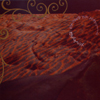 M.V. Carbon and J. Gräf make noise that is slow, consumptive, andjello-thick and their method of ear-shattering is unique enough to makethem stand out among a sea of amateur feedback wankers. Keyboardsstretch and rattle like whale blubber waving in the wind and sonicwhines break the sound barrier in an attempt to reach light and breakit, too, but through all the chaos and unchecked sludge is that hint ofintention and arrangement that helps everything make sense. Metaluxmight have one foot in the out-of-control world of schizophrenic soundconstruction, but the other is firmly planted in the calm and coolrealm of careful preparation. After turning up their aggression theyconsider the variety they've presented, look it over like some hellishFrankenstein made from the bones of destroyed drum kits and nuclearguitars, and they craft it into rolling lines of synthetic bubbles andpurring sex kittens. Carbon and Gräf open up noise and reveal under itthe comedy of failing sounds; there are bloody llamas and pliantanimals to be found on this record. There's always a strange kind ofbeauty here that reminds me of why noise can be so great. Take theoverdriven guitar of "Splinter and Shimmer" for example: distortion,super-indulgence, and complete disregard for listener health has neversounded so lovely. The witch-like moan and screech of the vocals onthis track slip around the pure fucking animalistic drive of the guitarand the painful screech of electronics so perfectly, it's a surprisethat more individuals haven't tried this approach (it seems ripe fortheft and overuse). Metalux let it carry on for just long enough anddon't bother using it again—it's an addictive piece of songwriting thatonly increases with each listen. In other places the record is almostdanceable as drum machines pound away steady rhythms, alternatingbetween bass hits and persistent snare crunching. The noise that movesover it and the sometimes fascist ramblings of the vocalist create thekind of fear that only an epileptic thrust suddenly into a disco bashcould feel. "Airplane" and "Flexi-Armadillo" fit this bill well, butthere aren't just a few styles on this album. Nearly every song isunique and still Waiting for Armadillosticks together more cohesively than rock opera. "Rode West" soundslike it belongs in some world filled with secretly perverted clowns and"Mexico" might as well be put in every raver's CD player as a means ofterminally destroying their ability to dance and think. Both ofthem sound as though they were crafted from the same twisted brain andboth serve the greater purpose of lifting Waiting for Armadillo far above the usual onslaught of pummeling sound and into another dimension occupied only by itself.
M.V. Carbon and J. Gräf make noise that is slow, consumptive, andjello-thick and their method of ear-shattering is unique enough to makethem stand out among a sea of amateur feedback wankers. Keyboardsstretch and rattle like whale blubber waving in the wind and sonicwhines break the sound barrier in an attempt to reach light and breakit, too, but through all the chaos and unchecked sludge is that hint ofintention and arrangement that helps everything make sense. Metaluxmight have one foot in the out-of-control world of schizophrenic soundconstruction, but the other is firmly planted in the calm and coolrealm of careful preparation. After turning up their aggression theyconsider the variety they've presented, look it over like some hellishFrankenstein made from the bones of destroyed drum kits and nuclearguitars, and they craft it into rolling lines of synthetic bubbles andpurring sex kittens. Carbon and Gräf open up noise and reveal under itthe comedy of failing sounds; there are bloody llamas and pliantanimals to be found on this record. There's always a strange kind ofbeauty here that reminds me of why noise can be so great. Take theoverdriven guitar of "Splinter and Shimmer" for example: distortion,super-indulgence, and complete disregard for listener health has neversounded so lovely. The witch-like moan and screech of the vocals onthis track slip around the pure fucking animalistic drive of the guitarand the painful screech of electronics so perfectly, it's a surprisethat more individuals haven't tried this approach (it seems ripe fortheft and overuse). Metalux let it carry on for just long enough anddon't bother using it again—it's an addictive piece of songwriting thatonly increases with each listen. In other places the record is almostdanceable as drum machines pound away steady rhythms, alternatingbetween bass hits and persistent snare crunching. The noise that movesover it and the sometimes fascist ramblings of the vocalist create thekind of fear that only an epileptic thrust suddenly into a disco bashcould feel. "Airplane" and "Flexi-Armadillo" fit this bill well, butthere aren't just a few styles on this album. Nearly every song isunique and still Waiting for Armadillosticks together more cohesively than rock opera. "Rode West" soundslike it belongs in some world filled with secretly perverted clowns and"Mexico" might as well be put in every raver's CD player as a means ofterminally destroying their ability to dance and think. Both ofthem sound as though they were crafted from the same twisted brain andboth serve the greater purpose of lifting Waiting for Armadillo far above the usual onslaught of pummeling sound and into another dimension occupied only by itself.  M.V. Carbon and J. Gräf make noise that is slow, consumptive, andjello-thick and their method of ear-shattering is unique enough to makethem stand out among a sea of amateur feedback wankers. Keyboardsstretch and rattle like whale blubber waving in the wind and sonicwhines break the sound barrier in an attempt to reach light and breakit, too, but through all the chaos and unchecked sludge is that hint ofintention and arrangement that helps everything make sense. Metaluxmight have one foot in the out-of-control world of schizophrenic soundconstruction, but the other is firmly planted in the calm and coolrealm of careful preparation. After turning up their aggression theyconsider the variety they've presented, look it over like some hellishFrankenstein made from the bones of destroyed drum kits and nuclearguitars, and they craft it into rolling lines of synthetic bubbles andpurring sex kittens. Carbon and Gräf open up noise and reveal under itthe comedy of failing sounds; there are bloody llamas and pliantanimals to be found on this record. There's always a strange kind ofbeauty here that reminds me of why noise can be so great. Take theoverdriven guitar of "Splinter and Shimmer" for example: distortion,super-indulgence, and complete disregard for listener health has neversounded so lovely. The witch-like moan and screech of the vocals onthis track slip around the pure fucking animalistic drive of the guitarand the painful screech of electronics so perfectly, it's a surprisethat more individuals haven't tried this approach (it seems ripe fortheft and overuse). Metalux let it carry on for just long enough anddon't bother using it again—it's an addictive piece of songwriting thatonly increases with each listen. In other places the record is almostdanceable as drum machines pound away steady rhythms, alternatingbetween bass hits and persistent snare crunching. The noise that movesover it and the sometimes fascist ramblings of the vocalist create thekind of fear that only an epileptic thrust suddenly into a disco bashcould feel. "Airplane" and "Flexi-Armadillo" fit this bill well, butthere aren't just a few styles on this album. Nearly every song isunique and still Waiting for Armadillosticks together more cohesively than rock opera. "Rode West" soundslike it belongs in some world filled with secretly perverted clowns and"Mexico" might as well be put in every raver's CD player as a means ofterminally destroying their ability to dance and think. Both ofthem sound as though they were crafted from the same twisted brain andboth serve the greater purpose of lifting Waiting for Armadillo far above the usual onslaught of pummeling sound and into another dimension occupied only by itself.
M.V. Carbon and J. Gräf make noise that is slow, consumptive, andjello-thick and their method of ear-shattering is unique enough to makethem stand out among a sea of amateur feedback wankers. Keyboardsstretch and rattle like whale blubber waving in the wind and sonicwhines break the sound barrier in an attempt to reach light and breakit, too, but through all the chaos and unchecked sludge is that hint ofintention and arrangement that helps everything make sense. Metaluxmight have one foot in the out-of-control world of schizophrenic soundconstruction, but the other is firmly planted in the calm and coolrealm of careful preparation. After turning up their aggression theyconsider the variety they've presented, look it over like some hellishFrankenstein made from the bones of destroyed drum kits and nuclearguitars, and they craft it into rolling lines of synthetic bubbles andpurring sex kittens. Carbon and Gräf open up noise and reveal under itthe comedy of failing sounds; there are bloody llamas and pliantanimals to be found on this record. There's always a strange kind ofbeauty here that reminds me of why noise can be so great. Take theoverdriven guitar of "Splinter and Shimmer" for example: distortion,super-indulgence, and complete disregard for listener health has neversounded so lovely. The witch-like moan and screech of the vocals onthis track slip around the pure fucking animalistic drive of the guitarand the painful screech of electronics so perfectly, it's a surprisethat more individuals haven't tried this approach (it seems ripe fortheft and overuse). Metalux let it carry on for just long enough anddon't bother using it again—it's an addictive piece of songwriting thatonly increases with each listen. In other places the record is almostdanceable as drum machines pound away steady rhythms, alternatingbetween bass hits and persistent snare crunching. The noise that movesover it and the sometimes fascist ramblings of the vocalist create thekind of fear that only an epileptic thrust suddenly into a disco bashcould feel. "Airplane" and "Flexi-Armadillo" fit this bill well, butthere aren't just a few styles on this album. Nearly every song isunique and still Waiting for Armadillosticks together more cohesively than rock opera. "Rode West" soundslike it belongs in some world filled with secretly perverted clowns and"Mexico" might as well be put in every raver's CD player as a means ofterminally destroying their ability to dance and think. Both ofthem sound as though they were crafted from the same twisted brain andboth serve the greater purpose of lifting Waiting for Armadillo far above the usual onslaught of pummeling sound and into another dimension occupied only by itself.  The true test of the heavily layered, over-produced combo pop song is usually whether it can be played out in a solo performance, say at the ubiquitous open stage café or around the campfire, and still be strongly maintained. The singer/songwriter performance augmented with one or two other instrumentalists, preferably none of whom are playing the same instrument, usually has a raw and unique group charm, especially when performance is more the focus than production.
The true test of the heavily layered, over-produced combo pop song is usually whether it can be played out in a solo performance, say at the ubiquitous open stage café or around the campfire, and still be strongly maintained. The singer/songwriter performance augmented with one or two other instrumentalists, preferably none of whom are playing the same instrument, usually has a raw and unique group charm, especially when performance is more the focus than production. The electrified gong that radiates through the beginning moments of "Makruna" and continues through its 38 minute duration marks a phantom presence that galvanizes the whole of these recordings. The track "Minya" was originally recorded as a solo live performance in 1999, but it used elements of sound that had been previously recorded by both Colin Potter and Andrew Chalk. Only 111 copies of this performance were made, but now a reworked version‚Äîalong with two new tracks‚Äîhas been released in an edition of 500 copies.
The electrified gong that radiates through the beginning moments of "Makruna" and continues through its 38 minute duration marks a phantom presence that galvanizes the whole of these recordings. The track "Minya" was originally recorded as a solo live performance in 1999, but it used elements of sound that had been previously recorded by both Colin Potter and Andrew Chalk. Only 111 copies of this performance were made, but now a reworked version—along with two new tracks—has been released in an edition of 500 copies.
 Conceived as a response to the worldwide media coverage of the first Gulf War in 1991, Switch On Warwas Charles Hayward's attempt to create a harsh, anti-musical statementthat would serve as an antidote to the barrage of media distortion anddisturbingly hypocrisies being promulgated by the government andmilitary. Binaurally recorded live in a deserted London morgue, Haywardnever expected the album to last longer than a year, as it was intendedto reflect the anger and sadness over those then-current events.Paradoxically, some 13 years on, this music seems more topical thanever, with George W. Bush's bloodier sequel to the Gulf War stillraging on and the media ever more complacent and contradictory. Switch On War is subtitled Music for the Ongoing Theatre of War,a name that seems like it could have been lifted directly from thepolitically charged, anti-government lyrical screeds of This Heat, theseminal post-punk experimental group that Charles Hayward co-founded in1978. Hayward uses pretty much the same arsenal here as he did withThis Heat (and Gong, Quiet Sun, Camberwell Now and Coil); live andsynthetic percussion, augmented by layers of distortion and harsh tapeloops. The sound is immediately reminiscent of the industrialagitations of Throbbing Gristle, SPK and Einstürzende Neubauten,guaranteeing that it will be an extremely trying listen for most.Sheets of unpleasant distortion and ear-canal vibrating drones shiftsubtly along with Hayward's mechanical rhythms, scrupulously avoidingmelody in favor of abstract dot-matrix patterns that emerge overextended periods of time. At the start of "Crying Shame," Haywardshrieks a series of razor-sharp provocations: "Drive a sadmaninsane/Need a badman to blame/Oceans of flame/Reign of terror/Bone-dryterrain." His harshly synthetic soundworld evokes the arid dessert asseen through ultramodern infrared night-vision cameras, the landscapereduced to muddled electron midnight-greens and blues. Sudden swoops ofreverberating mechanical rhythms and ear-ringing treble tones signalthe dropping of bombs from aircraft, with fiber-optic cameras on theend of missiles tracing their descent down through the night sky andinto aspirin factories and impoverished public housing buildings.Hayward frequently utilizes the electronic bleeptones and repetitive,simplistic melodies reminiscent of video arcade games, drawing aparallel between spotty teenagers playing out shoot-'em-up fantasieswith their joysticks, and post-pubescent soldiers destroying the worldwith their high-tech gadgets and weaponry. Switch On War is a powerful aesthetic statement of brutally urgent relevance.
Conceived as a response to the worldwide media coverage of the first Gulf War in 1991, Switch On Warwas Charles Hayward's attempt to create a harsh, anti-musical statementthat would serve as an antidote to the barrage of media distortion anddisturbingly hypocrisies being promulgated by the government andmilitary. Binaurally recorded live in a deserted London morgue, Haywardnever expected the album to last longer than a year, as it was intendedto reflect the anger and sadness over those then-current events.Paradoxically, some 13 years on, this music seems more topical thanever, with George W. Bush's bloodier sequel to the Gulf War stillraging on and the media ever more complacent and contradictory. Switch On War is subtitled Music for the Ongoing Theatre of War,a name that seems like it could have been lifted directly from thepolitically charged, anti-government lyrical screeds of This Heat, theseminal post-punk experimental group that Charles Hayward co-founded in1978. Hayward uses pretty much the same arsenal here as he did withThis Heat (and Gong, Quiet Sun, Camberwell Now and Coil); live andsynthetic percussion, augmented by layers of distortion and harsh tapeloops. The sound is immediately reminiscent of the industrialagitations of Throbbing Gristle, SPK and Einstürzende Neubauten,guaranteeing that it will be an extremely trying listen for most.Sheets of unpleasant distortion and ear-canal vibrating drones shiftsubtly along with Hayward's mechanical rhythms, scrupulously avoidingmelody in favor of abstract dot-matrix patterns that emerge overextended periods of time. At the start of "Crying Shame," Haywardshrieks a series of razor-sharp provocations: "Drive a sadmaninsane/Need a badman to blame/Oceans of flame/Reign of terror/Bone-dryterrain." His harshly synthetic soundworld evokes the arid dessert asseen through ultramodern infrared night-vision cameras, the landscapereduced to muddled electron midnight-greens and blues. Sudden swoops ofreverberating mechanical rhythms and ear-ringing treble tones signalthe dropping of bombs from aircraft, with fiber-optic cameras on theend of missiles tracing their descent down through the night sky andinto aspirin factories and impoverished public housing buildings.Hayward frequently utilizes the electronic bleeptones and repetitive,simplistic melodies reminiscent of video arcade games, drawing aparallel between spotty teenagers playing out shoot-'em-up fantasieswith their joysticks, and post-pubescent soldiers destroying the worldwith their high-tech gadgets and weaponry. Switch On War is a powerful aesthetic statement of brutally urgent relevance. 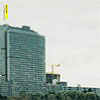 Radian's third full-length album is an unexpected (and excellent) surprise, appearing only months after the releases of Ballroom by Trapist (Martin Brandlmayr with Martin Siewert and Joe Williamson) and Die Instabilität der Symmetrie (the collaboration of Brandlmayr and Siewert with Werner Dafeldecker and Stefan Németh) and mere months before Jealousy and Diamond, the Kranky debut of the band Autistic Daughters (Brandlmayr and Dafeldecker with Dean Roberts). Juxtapositionis a seemingly appropriate name for the album as the recordings werecompleted in a process which is nearly backwards to what would seemmost logical: beginning with the synths and electronics (in Vienna) andcompleted with the recording of live drums and bass guitar (by JohnMcEntire in Chicago). Unsurprisingly with two drummers (Brandlmayer andMcEntire) having so much influence on the album, it's a veryrhythmically charged record. "Shift" opens the album with an aggressivetune of driving percussion over chopped up electronics. Even here onthe first track, the brushes of cymbals and thud of the real bassguitar combined with the forward melodic motion are sounds I've wantedto hear come out of this scene for years. These are the elements thatmake the perfect use of the last ten years of laptopery. Sure, thoseMego and Raster-Noton acts had good sound patches but the picture wasalways incomplete without good composition and variety. Juxtapositionis more of a pop record than the other releases in this blossomingscene, as it's comprised of nine approximately five-minute songsinstead of four-five 10-20 minute long pieces like some of theaforementioned records. The instrumentation remains a consistentwell-balanced interplay between the three musical elements (drums, bassguitar, and electronics) while the variants from song to song are oftempo and structure. While the sounds themselves aren't completelynatural, it's not an alien pop concept to have an upbeat tune (like"Transistor") followed by the downbeat song ("Helix") and a subsequentdroning bit ("Ontario") before launching into another upbeat jam("Tester"). I'm now even more eager to hear the upcoming AutisticDaughters release and am increasingly anxious to see some of thesepeople live but whether or not this blossoming scene has caught on wellenough to bring them over is yet to be seen.
Radian's third full-length album is an unexpected (and excellent) surprise, appearing only months after the releases of Ballroom by Trapist (Martin Brandlmayr with Martin Siewert and Joe Williamson) and Die Instabilität der Symmetrie (the collaboration of Brandlmayr and Siewert with Werner Dafeldecker and Stefan Németh) and mere months before Jealousy and Diamond, the Kranky debut of the band Autistic Daughters (Brandlmayr and Dafeldecker with Dean Roberts). Juxtapositionis a seemingly appropriate name for the album as the recordings werecompleted in a process which is nearly backwards to what would seemmost logical: beginning with the synths and electronics (in Vienna) andcompleted with the recording of live drums and bass guitar (by JohnMcEntire in Chicago). Unsurprisingly with two drummers (Brandlmayer andMcEntire) having so much influence on the album, it's a veryrhythmically charged record. "Shift" opens the album with an aggressivetune of driving percussion over chopped up electronics. Even here onthe first track, the brushes of cymbals and thud of the real bassguitar combined with the forward melodic motion are sounds I've wantedto hear come out of this scene for years. These are the elements thatmake the perfect use of the last ten years of laptopery. Sure, thoseMego and Raster-Noton acts had good sound patches but the picture wasalways incomplete without good composition and variety. Juxtapositionis more of a pop record than the other releases in this blossomingscene, as it's comprised of nine approximately five-minute songsinstead of four-five 10-20 minute long pieces like some of theaforementioned records. The instrumentation remains a consistentwell-balanced interplay between the three musical elements (drums, bassguitar, and electronics) while the variants from song to song are oftempo and structure. While the sounds themselves aren't completelynatural, it's not an alien pop concept to have an upbeat tune (like"Transistor") followed by the downbeat song ("Helix") and a subsequentdroning bit ("Ontario") before launching into another upbeat jam("Tester"). I'm now even more eager to hear the upcoming AutisticDaughters release and am increasingly anxious to see some of thesepeople live but whether or not this blossoming scene has caught on wellenough to bring them over is yet to be seen.  While it's hard to speculate about the influence that this reissue willhave on even the smallest of fringe interest groups, without soundinglike a geeky sound-art fetishist or conspiracy nut myself, I will admitat least that after three years delay, The Conet Project repress has me more excited than any record to receive reissue treatment in 2004. This is notto say that I have really enjoyed listening to most of theserecordings, at least not for any extended period, the reason being thatthe four-disc set is absolutely the most intense piece of media I'veencountered since its initial release in 1998. "Numbers stations," forthose who ignored this colossus the first time around, are short-waveradio broadcasts appearing (still) around the clock, transmitting avariety of encoded messages, next to impossible to source, decode, ortrace to a recipient. The messages come via human voices readingnumbers and phonetic letters, series of Morse-coded letters andnumbers, or longer "noise" transmissions, producing different strainsof noise and occasionally snippets of music. This collection (the firstever) is not intense within conventional or, in these days, fashionable"noise" definitions. Rather, the effect must be traced deeper, beyondany surface appeal and into the unrelenting atmosphere these recordingsproduce. Better yet, in a contradictory reading that would support theparanoid "sourceless-ness" that is certainly a theme here, theintensity in the mood of The Conet Project might also be linked to the sounds' unique existence at the surface only,as purely utilitarian noises of unknown, or at least inconceivablecontext. Recently, numbers stations entered the popular mind via asample (from disc 1) that became the haunting invocation"Yankee...Hotel...Foxtrot" in a song from the Wilco album of the samename. The fact that the band selected such a bizarre find for bothprominent placement within one their most powerful songs, and for thetitle of an album epic in its look at emotional isolationism, should beevidence of the captivating power latent in many of these recordings,regardless of their association with the government intelligence groupsand espionage agents that are their most likely sources. While it canbe thrilling to sit and imagine the global impact of one particularseries of stuttered, Slavic letters or static-laden Sousa loop, thesediscs become most effective when the frequencies are allowed to slowlypopulate the airspace, to become, in this archival format, like theghostly remnants of human activity twice removed, a census of blackshadows against the sky's gray analog. The warped, muddied sound of thebroadcasts grants each a discomforting distance, less paranoia-inducingthan simply numbing. To listen is to confront a vast field of inhumanbabble, coated in the noisy resonances of antique equipment,long-distance signaling, and extra-mechanical production. These aremarginally human transmissions, meant to appear timeless, to miss yourears, transmissions largely forgotten, or remembered only in thelog-books of an anonymous conglomerate. This is the true cyber-punksound, "music" which predicts a future of annihilation, replacement,and empty language. It is especially apt that The Conet Projectis being marketed to the experimental electronic crowd, as the moodhere seems a virtual compendium of the accomplishments of labels likeRaster-Noton, 12k, Fällt et al. These labels' pursuit of a reduction ora microscoping of musical forms through delineated digital languageoften threatens the same blank stare that I receive from Conet,intended or not. Here is proof that our music has evolved and left usbehind, in futile struggle to decode it, to connect its makers withourselves, to reach inside it and come up with something other thanevidence of our own growing insignificance.
While it's hard to speculate about the influence that this reissue willhave on even the smallest of fringe interest groups, without soundinglike a geeky sound-art fetishist or conspiracy nut myself, I will admitat least that after three years delay, The Conet Project repress has me more excited than any record to receive reissue treatment in 2004. This is notto say that I have really enjoyed listening to most of theserecordings, at least not for any extended period, the reason being thatthe four-disc set is absolutely the most intense piece of media I'veencountered since its initial release in 1998. "Numbers stations," forthose who ignored this colossus the first time around, are short-waveradio broadcasts appearing (still) around the clock, transmitting avariety of encoded messages, next to impossible to source, decode, ortrace to a recipient. The messages come via human voices readingnumbers and phonetic letters, series of Morse-coded letters andnumbers, or longer "noise" transmissions, producing different strainsof noise and occasionally snippets of music. This collection (the firstever) is not intense within conventional or, in these days, fashionable"noise" definitions. Rather, the effect must be traced deeper, beyondany surface appeal and into the unrelenting atmosphere these recordingsproduce. Better yet, in a contradictory reading that would support theparanoid "sourceless-ness" that is certainly a theme here, theintensity in the mood of The Conet Project might also be linked to the sounds' unique existence at the surface only,as purely utilitarian noises of unknown, or at least inconceivablecontext. Recently, numbers stations entered the popular mind via asample (from disc 1) that became the haunting invocation"Yankee...Hotel...Foxtrot" in a song from the Wilco album of the samename. The fact that the band selected such a bizarre find for bothprominent placement within one their most powerful songs, and for thetitle of an album epic in its look at emotional isolationism, should beevidence of the captivating power latent in many of these recordings,regardless of their association with the government intelligence groupsand espionage agents that are their most likely sources. While it canbe thrilling to sit and imagine the global impact of one particularseries of stuttered, Slavic letters or static-laden Sousa loop, thesediscs become most effective when the frequencies are allowed to slowlypopulate the airspace, to become, in this archival format, like theghostly remnants of human activity twice removed, a census of blackshadows against the sky's gray analog. The warped, muddied sound of thebroadcasts grants each a discomforting distance, less paranoia-inducingthan simply numbing. To listen is to confront a vast field of inhumanbabble, coated in the noisy resonances of antique equipment,long-distance signaling, and extra-mechanical production. These aremarginally human transmissions, meant to appear timeless, to miss yourears, transmissions largely forgotten, or remembered only in thelog-books of an anonymous conglomerate. This is the true cyber-punksound, "music" which predicts a future of annihilation, replacement,and empty language. It is especially apt that The Conet Projectis being marketed to the experimental electronic crowd, as the moodhere seems a virtual compendium of the accomplishments of labels likeRaster-Noton, 12k, Fällt et al. These labels' pursuit of a reduction ora microscoping of musical forms through delineated digital languageoften threatens the same blank stare that I receive from Conet,intended or not. Here is proof that our music has evolved and left usbehind, in futile struggle to decode it, to connect its makers withourselves, to reach inside it and come up with something other thanevidence of our own growing insignificance. 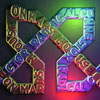 The first full length album of all new Mouse On Mars music in threeyears is easily one of the most fun records of the year. Andi and Janare once again joined in the studio by vocalist Dodo Nkishi and, alongwith female vocalist Niobe, for the first time, the entire Mouse OnMars record is covered with vocals. The strong points are very strong:the undeniably most bombastic jam of the year is "Blood Comes," which,along with tracks like the opener "Mine Is Yours," and "Wipe ThatSound," are excellent homages to bottom-heavy retro-funk put through adigital mindwarp that Mouse On Mars excel at. "Blood Comes" plays in myhead to images of urban roller skaters in San Francisco, speeding downthe hills backwards with a ghetto blaster on one shoulder. It's aperfect balance of punchy beats, hot riffs, and noise. "Mine Is Yours"is a brilliant opener with guitars adding more human colors andtextures to the music, which is historically quite alien. However, I'mnot quite sure if I'm ready for the vocals from Niobe, as the songs"The End," "Send Me Shivers," and "Evoke an Object" are somewhat tepidattempts at a kind of generic easily digestible coffee house techno.While they do work as good resting points between the relentless energyof the other songs, they're rather underdeveloped and lacking inexcellent hooks. It almost doesn't matter, though, as the memories ofthe high points are good enough to leave the important lastingimpressions and warrant repeated listens.
The first full length album of all new Mouse On Mars music in threeyears is easily one of the most fun records of the year. Andi and Janare once again joined in the studio by vocalist Dodo Nkishi and, alongwith female vocalist Niobe, for the first time, the entire Mouse OnMars record is covered with vocals. The strong points are very strong:the undeniably most bombastic jam of the year is "Blood Comes," which,along with tracks like the opener "Mine Is Yours," and "Wipe ThatSound," are excellent homages to bottom-heavy retro-funk put through adigital mindwarp that Mouse On Mars excel at. "Blood Comes" plays in myhead to images of urban roller skaters in San Francisco, speeding downthe hills backwards with a ghetto blaster on one shoulder. It's aperfect balance of punchy beats, hot riffs, and noise. "Mine Is Yours"is a brilliant opener with guitars adding more human colors andtextures to the music, which is historically quite alien. However, I'mnot quite sure if I'm ready for the vocals from Niobe, as the songs"The End," "Send Me Shivers," and "Evoke an Object" are somewhat tepidattempts at a kind of generic easily digestible coffee house techno.While they do work as good resting points between the relentless energyof the other songs, they're rather underdeveloped and lacking inexcellent hooks. It almost doesn't matter, though, as the memories ofthe high points are good enough to leave the important lastingimpressions and warrant repeated listens.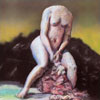 This compilation neatly fills in some gaps for collectors of the longand varied career of Mayo Thomspon and his mercurial,on-again/off-again rock outfit The Red Krayola. Comprising 21 tracksdrawn from twelve 7", 12" and CD singles released from 1970 to 2002,most songs are credited to the various lineups of The Red Krayola, witha couple bearing the name of Mayo Thompson solo, the short-lived sidegroup Saddlesore, and a few sharing credit with conceptual art groupArt & Language. Anyone versed in the career of The Red Krayolaunderstands that the primary watchword is eclecticism. From theirbeginnings in Texas garage psychedelia, Thompson has taken his projectthrough avant-garde Residents-style insanity, country-rock, punk-disco,No Wave and post-rock. Along the way, Thompson has remained the onlyanchor of the band, which at various times has included hundreds ofothers, including members of Pere Ubu, X-Ray Spex, Essential Logic,Raincoats and Swell Maps, as well as contemporary indie mainstays JimO'Rourke, David Grubbs and John McEntire. If one thing has stayed thesame throughout the 36 years of the band's existence, it is theadventurousness and intelligence with which Thompson and companyapproach these myriad styles, and their continuing, nervous dialoguewith pop music and other commercially viable forms. Though the singleis, by its nature, the most commercial face of music, The Red Krayolahave used this carrier as a way to keep in touch with the pop world,even as they held it at an arm's length, with their deconstructions andcommentaries on rock. It's hard to detect this stance in the album'sfirst three tracks, dating from 1970, which utilize country-influencedpsych-rock to capable but ultimately head-scratching effect. Fromthere, a 1976 single "Wives in Orbit/Yik Yak" demonstrated Thompson'sgrowing interest in the stripped-down aesthetic of punk rock, with apair of cleverly rendered art-punk songs that rival the best of theoriginal punk singles era. Tracks 6-13 represent my favorite period ofRed Krayola's manifestation: his flirtations with No Wave, working witha band that included members of the aforementioned post-punk groups."Micro-chips and Fish" is an idiosyncratic reggae-punk song featuringthe saxophone blasts of Lora "Oh Bondage, Up Yours" Logic. Successivetracks tackle the atonal skronk of No Wave, with Thompson's lyricsdealing with abstruse linguistic philosophy, or narratives about Muslimswordfighters operating as allegories for the destructive power ofreligion. The "Rattenmensch" single, released on an obscure Germanlabel in 1981, features a musical take on Freud's famous "rat man" casestudy, using German lyrics taken from Freud's writings, incorporatedinto an angular New Wave framework. The rest of the singles collectedon the disc document Thompson's 1993-2002 work released on Drag City,his most experimental period, characterized by highly idiosyncraticcompositions combining unorthodox rhythms with jagged guitarimprovisations, unexpected samples, synthesizers and surrealisticlyrical routines. "Come on Down" is a good example of the artsierKrayola, originally a bonus single included with the first pressing ofthe FingerpaintingLP, is an oddly dislocated ballad that bounces along with a galaxy ofstunted electronics and sudden tangents into free-form noise. Takentogether, these 21 songs construct a stunning collage-portrait of anartist in constant flux, never failing through four decades to find newmethods of expression and the transmission of new ideas.
This compilation neatly fills in some gaps for collectors of the longand varied career of Mayo Thomspon and his mercurial,on-again/off-again rock outfit The Red Krayola. Comprising 21 tracksdrawn from twelve 7", 12" and CD singles released from 1970 to 2002,most songs are credited to the various lineups of The Red Krayola, witha couple bearing the name of Mayo Thompson solo, the short-lived sidegroup Saddlesore, and a few sharing credit with conceptual art groupArt & Language. Anyone versed in the career of The Red Krayolaunderstands that the primary watchword is eclecticism. From theirbeginnings in Texas garage psychedelia, Thompson has taken his projectthrough avant-garde Residents-style insanity, country-rock, punk-disco,No Wave and post-rock. Along the way, Thompson has remained the onlyanchor of the band, which at various times has included hundreds ofothers, including members of Pere Ubu, X-Ray Spex, Essential Logic,Raincoats and Swell Maps, as well as contemporary indie mainstays JimO'Rourke, David Grubbs and John McEntire. If one thing has stayed thesame throughout the 36 years of the band's existence, it is theadventurousness and intelligence with which Thompson and companyapproach these myriad styles, and their continuing, nervous dialoguewith pop music and other commercially viable forms. Though the singleis, by its nature, the most commercial face of music, The Red Krayolahave used this carrier as a way to keep in touch with the pop world,even as they held it at an arm's length, with their deconstructions andcommentaries on rock. It's hard to detect this stance in the album'sfirst three tracks, dating from 1970, which utilize country-influencedpsych-rock to capable but ultimately head-scratching effect. Fromthere, a 1976 single "Wives in Orbit/Yik Yak" demonstrated Thompson'sgrowing interest in the stripped-down aesthetic of punk rock, with apair of cleverly rendered art-punk songs that rival the best of theoriginal punk singles era. Tracks 6-13 represent my favorite period ofRed Krayola's manifestation: his flirtations with No Wave, working witha band that included members of the aforementioned post-punk groups."Micro-chips and Fish" is an idiosyncratic reggae-punk song featuringthe saxophone blasts of Lora "Oh Bondage, Up Yours" Logic. Successivetracks tackle the atonal skronk of No Wave, with Thompson's lyricsdealing with abstruse linguistic philosophy, or narratives about Muslimswordfighters operating as allegories for the destructive power ofreligion. The "Rattenmensch" single, released on an obscure Germanlabel in 1981, features a musical take on Freud's famous "rat man" casestudy, using German lyrics taken from Freud's writings, incorporatedinto an angular New Wave framework. The rest of the singles collectedon the disc document Thompson's 1993-2002 work released on Drag City,his most experimental period, characterized by highly idiosyncraticcompositions combining unorthodox rhythms with jagged guitarimprovisations, unexpected samples, synthesizers and surrealisticlyrical routines. "Come on Down" is a good example of the artsierKrayola, originally a bonus single included with the first pressing ofthe FingerpaintingLP, is an oddly dislocated ballad that bounces along with a galaxy ofstunted electronics and sudden tangents into free-form noise. Takentogether, these 21 songs construct a stunning collage-portrait of anartist in constant flux, never failing through four decades to find newmethods of expression and the transmission of new ideas.samples:
 It's utterly unfortunate when I can listen to a band and tell either their influences or what band they're trying to sound like on almost every track. Especially when said band shows musicianship and skill that could very well spawn a truly unique and powerful sound. Sadly, this album is not the record that reveals this untapped talent for The Plastic Constellations.
It's utterly unfortunate when I can listen to a band and tell either their influences or what band they're trying to sound like on almost every track. Especially when said band shows musicianship and skill that could very well spawn a truly unique and powerful sound. Sadly, this album is not the record that reveals this untapped talent for The Plastic Constellations.
 Writinggood music is an incredibly difficult thing to do. Knowing this andconsidering how easy it has become to make music in a home basement, Ishouldn't be surprised that seriously bad songwriting is rearing itsugly head more frequently. Cobra Killer's punkish attitude and totaldisregard for anything truly igneous creates the kind of sterileenvironment that could kill any erection and hurl any optimistic,music-loving, passionate human being into the kind of depression thatusually ends up stinking of alcohol and all-night country music binges.76/77 opens up with "Let's Have a Problem," a rhythm-centeredexercise in monotone vocals, monotonous loops, and melodies that PaulOakenfold might've had something to do with. Fortunately this is not anindication of all of what is to come. "Mund Auf - Augen Zu (SteckerRaus, Ich Dreh' Durch)" contains one part catchiness, two partshalf-awake vocals, and just a hint of personal satisfaction. It is asimple track that succeeds by sticking to what works... over and overagain. It's not the greatest song in the world, but it sticks out likea zit on the face of a Hollywood actress. "Chemie Des Alltags" returnsthe album to the state of mediocrity that "Let's Have a Problem" madeso painfully obvious and, with one exception, the album never reallystrays away from that blandness. How in the hell "High is the Pine"made it onto this record might as well be one of the nation's greatestmysteries. For just 3 minutes and 14 seconds, Cobra Killer puts awaytheir super-trendy, wanna-be punk 'tude and sings an amazingly gorgeoussong with a popping guitar line and swooping strings backed in grandeurby the (gasp!) vocals that actually hint at a melody that doesn't relyon just three tones. The problem with something like this has to bethat its all glam and no substance. Regardless of how under MTV's radarit might be, that doesn't change the fact that it's a painful blend ofbland writing and fake fucking personality. I'm sick of the posing, I'msick of the flashy sound effects and "groundbreaking" song structures:these songs (with one exception) have no soul! And, in addition,there's nothing new or surprising here. It's not as though Cobra Killerwas trying something new and just failed, 76/77 doesn't do anything that can't be done by any band who has material available at the local mall.
Writinggood music is an incredibly difficult thing to do. Knowing this andconsidering how easy it has become to make music in a home basement, Ishouldn't be surprised that seriously bad songwriting is rearing itsugly head more frequently. Cobra Killer's punkish attitude and totaldisregard for anything truly igneous creates the kind of sterileenvironment that could kill any erection and hurl any optimistic,music-loving, passionate human being into the kind of depression thatusually ends up stinking of alcohol and all-night country music binges.76/77 opens up with "Let's Have a Problem," a rhythm-centeredexercise in monotone vocals, monotonous loops, and melodies that PaulOakenfold might've had something to do with. Fortunately this is not anindication of all of what is to come. "Mund Auf - Augen Zu (SteckerRaus, Ich Dreh' Durch)" contains one part catchiness, two partshalf-awake vocals, and just a hint of personal satisfaction. It is asimple track that succeeds by sticking to what works... over and overagain. It's not the greatest song in the world, but it sticks out likea zit on the face of a Hollywood actress. "Chemie Des Alltags" returnsthe album to the state of mediocrity that "Let's Have a Problem" madeso painfully obvious and, with one exception, the album never reallystrays away from that blandness. How in the hell "High is the Pine"made it onto this record might as well be one of the nation's greatestmysteries. For just 3 minutes and 14 seconds, Cobra Killer puts awaytheir super-trendy, wanna-be punk 'tude and sings an amazingly gorgeoussong with a popping guitar line and swooping strings backed in grandeurby the (gasp!) vocals that actually hint at a melody that doesn't relyon just three tones. The problem with something like this has to bethat its all glam and no substance. Regardless of how under MTV's radarit might be, that doesn't change the fact that it's a painful blend ofbland writing and fake fucking personality. I'm sick of the posing, I'msick of the flashy sound effects and "groundbreaking" song structures:these songs (with one exception) have no soul! And, in addition,there's nothing new or surprising here. It's not as though Cobra Killerwas trying something new and just failed, 76/77 doesn't do anything that can't be done by any band who has material available at the local mall.  Some bands seem like they have it all figured out ahead of time, likesome grand plan or marketing package that can get them into the rightclubs or buyer segments. At first glance, Sluts of Trust had that feelto me: raunchy name for just enough controversy; odd publicity photoswith bygone era stylings; all the right indie rock credentials, likecoming from the right city with the right backing and having very fewmembers like the current band the kids are crazy for. As soon as themusic is heard, though, these appearance melt right away in therealization that Sluts of Trust are the real deal, a rock act withfire, talent, and a lot of moxy. The album opens with ferocity, a tightsound, and both laidback Scottish delivery and whooping with occasionalwails. The vocals tend to be faded in the mix a bit, like they weredelivered with a megaphone across the room from the microphone in thestudio, but they can still be understood. Then, inexplicably, at thebeginning of the second track, an explosive hair metal guitar lickgives way to an almost funk feel on "Piece of You." The song soarshigher and higher as the action builds, only to relax into the samegroove. John McFarlane's delivery is almost strained, like he's barelyholding it all in, and the instruments sound taxed by the forces thatdrive them. Sure, there's some comedy afoot ("Tighter Than the Night"is a great example), and the accent is almost purely indecipherable attimes or just thickly lathered on for effect. But even when McFarlanescreams "Might is right" or "I don't want pain, I want pleasure/We alltake the pain if it makes the pleasure better" it sounds sincereenough. "Dominoes" is a definite highlight, with plaintive vocals andgentle guitar breaking into a nice roll that approaches beauty althoughit never quite gets there. This is a band to watch with anticipation,for sure, and the niche they have found will easily provide them fodderfor years to come.
Some bands seem like they have it all figured out ahead of time, likesome grand plan or marketing package that can get them into the rightclubs or buyer segments. At first glance, Sluts of Trust had that feelto me: raunchy name for just enough controversy; odd publicity photoswith bygone era stylings; all the right indie rock credentials, likecoming from the right city with the right backing and having very fewmembers like the current band the kids are crazy for. As soon as themusic is heard, though, these appearance melt right away in therealization that Sluts of Trust are the real deal, a rock act withfire, talent, and a lot of moxy. The album opens with ferocity, a tightsound, and both laidback Scottish delivery and whooping with occasionalwails. The vocals tend to be faded in the mix a bit, like they weredelivered with a megaphone across the room from the microphone in thestudio, but they can still be understood. Then, inexplicably, at thebeginning of the second track, an explosive hair metal guitar lickgives way to an almost funk feel on "Piece of You." The song soarshigher and higher as the action builds, only to relax into the samegroove. John McFarlane's delivery is almost strained, like he's barelyholding it all in, and the instruments sound taxed by the forces thatdrive them. Sure, there's some comedy afoot ("Tighter Than the Night"is a great example), and the accent is almost purely indecipherable attimes or just thickly lathered on for effect. But even when McFarlanescreams "Might is right" or "I don't want pain, I want pleasure/We alltake the pain if it makes the pleasure better" it sounds sincereenough. "Dominoes" is a definite highlight, with plaintive vocals andgentle guitar breaking into a nice roll that approaches beauty althoughit never quite gets there. This is a band to watch with anticipation,for sure, and the niche they have found will easily provide them fodderfor years to come. 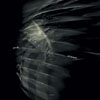 Had the promise of the first track on this record carried through, I'd be ranting and raving about an extraordinary work of sound manipulation and minimal composition right now. Unfortunately the first track does feel like a standout on this Shimmer and puts the remaining seven songs to shame. Jasch has a great ear that allows him to do more than just slap sounds together in a creative way; he gets into sounds and recognizes their beginning and end and chooses, from the perspective, how to organize a piece of music. The result is a broad spectrum of stuttering sounds, whining strings, deep bass growls, and static rushes that never quite leave the world of organization and dive into the realm of the subconscious world.
Had the promise of the first track on this record carried through, I'd be ranting and raving about an extraordinary work of sound manipulation and minimal composition right now. Unfortunately the first track does feel like a standout on this Shimmer and puts the remaining seven songs to shame. Jasch has a great ear that allows him to do more than just slap sounds together in a creative way; he gets into sounds and recognizes their beginning and end and chooses, from the perspective, how to organize a piece of music. The result is a broad spectrum of stuttering sounds, whining strings, deep bass growls, and static rushes that never quite leave the world of organization and dive into the realm of the subconscious world.
 When the message is primarily about breaking down social and political barriers, it's only natural that the musical ones should be overstepped as well. For their third full-length release, the first for Ropeadope, the Brooklyn soldiers of Afrobeat open with the loaded question of "Who is This America Dem Speak of Today?"
When the message is primarily about breaking down social and political barriers, it's only natural that the musical ones should be overstepped as well. For their third full-length release, the first for Ropeadope, the Brooklyn soldiers of Afrobeat open with the loaded question of "Who is This America Dem Speak of Today?"
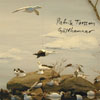 This 3" CD release is a nice idea that contains seven short and sweetsongs made for a summer in Sweden. The word "gästhamnar" translatesinto English as "guest harbours" and though I'm not quite sure what thedifference between a normal harbor and a guest harbor is, the image ofwater, boats, and people having fun certainly runs through every songon this disc. Each song uses a palette that is, in some ways, borrowedfrom each of the other songs. The synthesizers throughout these 18minutes of music always buzz in a very affecting way and the drums havethat lovely drum-stick-hitting-pillows sound that never allows thepercussion to become an intruder on the melody (no matter how drivingthe rhythms are). The songs always lilt along at a medium pace beforesurrendering to the next song and, with that surrendering, passing on anew variation that was inherent in the previous track. Patrik Torsson'scompositions remind me of childlike simplicity and, for the most part,they're never very busy. At the most there are three or fourinstruments at time, each interacting with the other to establish acurrent that swells and receeds naturally. With this in mind, I have tosay that I get bored very easily and that because much of this soundsfamiliar to me, I'm not over-impressed with Gästhamnar.The brevity of these recordings, however, kept boredom from becoming aproblem and I was able to appreciate these miniatures as being prettysongs meant for pretty days. A bit more variation would be key inmaking this more enjoyable. Eighteen minutes is plenty of time to addin extras here and there that would cure the redundancy blues.Torsson's music is innocent, sweet, and despite some monotonousqualities, enjoyable overall. I just wish he would've shaken things upa bit. Perhaps a good producer could improve the variety of soundwithout ruining Torsson's knack for decent songwriting.
This 3" CD release is a nice idea that contains seven short and sweetsongs made for a summer in Sweden. The word "gästhamnar" translatesinto English as "guest harbours" and though I'm not quite sure what thedifference between a normal harbor and a guest harbor is, the image ofwater, boats, and people having fun certainly runs through every songon this disc. Each song uses a palette that is, in some ways, borrowedfrom each of the other songs. The synthesizers throughout these 18minutes of music always buzz in a very affecting way and the drums havethat lovely drum-stick-hitting-pillows sound that never allows thepercussion to become an intruder on the melody (no matter how drivingthe rhythms are). The songs always lilt along at a medium pace beforesurrendering to the next song and, with that surrendering, passing on anew variation that was inherent in the previous track. Patrik Torsson'scompositions remind me of childlike simplicity and, for the most part,they're never very busy. At the most there are three or fourinstruments at time, each interacting with the other to establish acurrent that swells and receeds naturally. With this in mind, I have tosay that I get bored very easily and that because much of this soundsfamiliar to me, I'm not over-impressed with Gästhamnar.The brevity of these recordings, however, kept boredom from becoming aproblem and I was able to appreciate these miniatures as being prettysongs meant for pretty days. A bit more variation would be key inmaking this more enjoyable. Eighteen minutes is plenty of time to addin extras here and there that would cure the redundancy blues.Torsson's music is innocent, sweet, and despite some monotonousqualities, enjoyable overall. I just wish he would've shaken things upa bit. Perhaps a good producer could improve the variety of soundwithout ruining Torsson's knack for decent songwriting.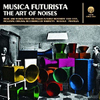 With the release of Musica Futuristica, LTM introduces their new sub-label Salon and presents a companion volume to Futurism & Dada Reviewed.This compilation includes all but one of the of Futurist tracks on theabove-mentioned CD and adds a variety of others from both major andminor players in the Futurist movement. As the result of a thoroughremastering of the archived originals, the quality of the recordings onMusica Futuristica is much better than on Futurism & Dada Reviewed.The disc opens with F.T. Marinetti reading the "Definition of Futurism"and calling for the use of sound and noise as weapons againsttraditionalism. For Marinetti and other Futurists, the roar of a carwas more beautiful than anything by Mozart or Beethoven. This desirefor noise can be found in "The Awakening of a City" by Luigi Russolo.In this composition, Russolo attempts to portray the dawning of a newcity, complete with its industrial sirens and abundant factorywhistles. Performance of the piece was initially banned in Italy forfear that it would "likely trigger a public disturbance." The droningnature of the work recalls the compositions of Pierre Henry and otherpractitioners of musique concrète, except for the fact that it predatesHenry by a few decades. The most interesting piece on the album isMarinetti's "Five Radio Sintesi," a series of five pieces thatincorporate found sound and make extensive use of silence. Dating from1933, the juxtaposition of disparate sound elements such as Americanfolk music, the sound of a stadium crowd, the hum of a car, and anoperatic vocal solo highlight the Futurists' desire to point out thebeauty to be find in the banal nature of quotidian existence. With theoutbreak of the Second World War, the Futurist movement faded as morepressing issues came to play in European society and the sonicexperiments of Marinetti, Russolo and others were not allowed to befurther explored. However, as Musica Futuristica demonstrates,the influence of these works can be seen across multiple genres, frommodern composition to avant-rock and electronica.
With the release of Musica Futuristica, LTM introduces their new sub-label Salon and presents a companion volume to Futurism & Dada Reviewed.This compilation includes all but one of the of Futurist tracks on theabove-mentioned CD and adds a variety of others from both major andminor players in the Futurist movement. As the result of a thoroughremastering of the archived originals, the quality of the recordings onMusica Futuristica is much better than on Futurism & Dada Reviewed.The disc opens with F.T. Marinetti reading the "Definition of Futurism"and calling for the use of sound and noise as weapons againsttraditionalism. For Marinetti and other Futurists, the roar of a carwas more beautiful than anything by Mozart or Beethoven. This desirefor noise can be found in "The Awakening of a City" by Luigi Russolo.In this composition, Russolo attempts to portray the dawning of a newcity, complete with its industrial sirens and abundant factorywhistles. Performance of the piece was initially banned in Italy forfear that it would "likely trigger a public disturbance." The droningnature of the work recalls the compositions of Pierre Henry and otherpractitioners of musique concrète, except for the fact that it predatesHenry by a few decades. The most interesting piece on the album isMarinetti's "Five Radio Sintesi," a series of five pieces thatincorporate found sound and make extensive use of silence. Dating from1933, the juxtaposition of disparate sound elements such as Americanfolk music, the sound of a stadium crowd, the hum of a car, and anoperatic vocal solo highlight the Futurists' desire to point out thebeauty to be find in the banal nature of quotidian existence. With theoutbreak of the Second World War, the Futurist movement faded as morepressing issues came to play in European society and the sonicexperiments of Marinetti, Russolo and others were not allowed to befurther explored. However, as Musica Futuristica demonstrates,the influence of these works can be seen across multiple genres, frommodern composition to avant-rock and electronica. - F.T. Marinetti - Definition of Futurism
- F.T. Marinetti - Five Radio Sintesi
- Luigi Russolo - The Awakening of a City
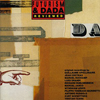 Released by LTM in 2000, Futurism & Dada Revieweddocuments the sonic experiments of these two respective art movements.While the Dadaists were primarily concerned with visual art and theFuturists with politics and literature, both groups were interested inthe burgeoning technology of audio reproduction and the possibilitiesit offered for revolutionary artistic creation. This compilation ofarchival recordings presents a wide variety of the Dada and Futristaudio projects, from sound poems and avant-garde compositions torecordings of interviews and manifestoes by major proponents of bothmovements. Unfortunately, due to the primitive recording technologyavailable during the first half of the 20th century, the poor qualityof these recordings is a constant reminder of the "avant-garde" natureof the work. As far as Futurist compositions on the compilation, all ofthe tracks on Futurism & Dada Reviewed can be found in remastered form on the recent Musica Futuristica,with the exception of Luigi Grandi's "Cavalli + Acciaio." On the Dadaside, the disc presents recordings of poems by Appolinaire, TristanTzara and Jean Cocteau, along with two compositions written by KurtSchwitters and Marcel Duchamp. Duchamp, known as one of the mostinfluential poets of the last century, was also an accomplishedcomposer and his composition "La Mariée mise a nu par ses Celibataires,même" shares its title with one of his most famous paintings. Themethod of composition employed by Duchamp foreshadows those to be usedlater by artists such as John Cage in their use of indeterminatecompositional techniques. Duchamp took numerous balls, assigning eachof them various notes, poured them into a funnel, and then allowed themto drop into the open trucks of a toy train in order to determine thetonal sequence of the composition. While the original version of thiscomposition was originally intended for piano, a new version isincluded on this compilation where the hammers of a piano are replacedwith a small rotary disc that vibrates the strings instead of strikingthem. Kurt Schwitter's composition "Die Sonata In Urlauten" employs thevoice in a variety in nonsensical utterances, song, and child-speak.Listening to Schwitters, it is easy to hear the influence of works likethis on Mike Patton and other contemporary vocal performers. While thequality of the recordings leaves a bit to offer, this compilation isstill of interest to anyone interested in art and music history andoffers a glimpse at groundbreaking compositions that opened up thepossibilities still being explored by contemporary composers andperformers.
Released by LTM in 2000, Futurism & Dada Revieweddocuments the sonic experiments of these two respective art movements.While the Dadaists were primarily concerned with visual art and theFuturists with politics and literature, both groups were interested inthe burgeoning technology of audio reproduction and the possibilitiesit offered for revolutionary artistic creation. This compilation ofarchival recordings presents a wide variety of the Dada and Futristaudio projects, from sound poems and avant-garde compositions torecordings of interviews and manifestoes by major proponents of bothmovements. Unfortunately, due to the primitive recording technologyavailable during the first half of the 20th century, the poor qualityof these recordings is a constant reminder of the "avant-garde" natureof the work. As far as Futurist compositions on the compilation, all ofthe tracks on Futurism & Dada Reviewed can be found in remastered form on the recent Musica Futuristica,with the exception of Luigi Grandi's "Cavalli + Acciaio." On the Dadaside, the disc presents recordings of poems by Appolinaire, TristanTzara and Jean Cocteau, along with two compositions written by KurtSchwitters and Marcel Duchamp. Duchamp, known as one of the mostinfluential poets of the last century, was also an accomplishedcomposer and his composition "La Mariée mise a nu par ses Celibataires,même" shares its title with one of his most famous paintings. Themethod of composition employed by Duchamp foreshadows those to be usedlater by artists such as John Cage in their use of indeterminatecompositional techniques. Duchamp took numerous balls, assigning eachof them various notes, poured them into a funnel, and then allowed themto drop into the open trucks of a toy train in order to determine thetonal sequence of the composition. While the original version of thiscomposition was originally intended for piano, a new version isincluded on this compilation where the hammers of a piano are replacedwith a small rotary disc that vibrates the strings instead of strikingthem. Kurt Schwitter's composition "Die Sonata In Urlauten" employs thevoice in a variety in nonsensical utterances, song, and child-speak.Listening to Schwitters, it is easy to hear the influence of works likethis on Mike Patton and other contemporary vocal performers. While thequality of the recordings leaves a bit to offer, this compilation isstill of interest to anyone interested in art and music history andoffers a glimpse at groundbreaking compositions that opened up thepossibilities still being explored by contemporary composers andperformers.- Marcel Duchamp - La Mariée mise a nu par ses Celibataires, même
- Kurt Schwitter - Die Sonata In Urlauten
- Jean Cocteau - Le Voleur Defants
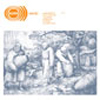 Masters of the stomach-churning, intestine-voiding, subharmonicfrequencies, Steven O'Malley and Greg Anderson return for a sequel tolast year's impressive White 1, not surprisingly entitled White 2.Much has been made of Anderson and O'Malley's transmogrification andmutation of their Nordic black metal influences into the slow-motion,doom-laden minimalism of their recordings as Sunn O))). Never mind thatit isn't a very original idea, having previously been put forth bySeattle ambient sludge-core band Earth. Listen to the track "Ripped onFascist Ideas" from Earth's live album Sunn Amps and Smashed Guitarsfor the origin of Sunn O)))'s sonic palette. To their credit, however,Sunn O))) have relentlessly pursued this aesthetic, going several stepsfurther with their use of variable-speed tape mutations and othersynthetic technology to create the lowest low-end feasible, with thepossible exception of that lowrider that cruises through myneighborhood in the middle of the night blasting bone-rattling Miamibass. On White 2, they choose not to repeat the guest-vocalist tactics of the first Whitealbum, in favor of creating three lengthy, horror movie soundscapesthat willfully test the limits of the stereo playback system, even asthey revel in fascinatingly tangible textures. Although they approachtheir compositions from a completely different perspective, Sunn O)))arrive in the same general "dark ambient" territory as Lustmord orLull, spinning vaguely cinematic post-industrial abstractions in whichmood is the primary attraction. The fourteen doom-laden minutes of"Hell-O)))-Ween" are the most prototypical of the band: a series ofbrutally plodding riffs that are allowed to reverberate, slowlybuilding up compounding layers distortion and bass rumble like slowlycoagulating amber dripping down a prehistoric tree. It's crushing anddowtrodden, but it's nothing compared to the next two epic tracks ofdesolation and fear. "bassAliens" explores the lonely, claustrophobiccorners just out of sight on Ridley Scott's Nostromo, hauntedby the faint specter of menace, distorted subharmonic rumbles thatsputter and mutate, spewing foul plumes of hydrochloric acid. What'sremarkable about this track is the effective usage of higher-frequencytones and midrange atmospheric guitar plonks, which, juxtaposed withthe jarring bass rumbles, create a vivid sound environment unmatched onSunn O)))'s previous records. The album concludes with the 25-minuteepic "Decay 2 (Nihil's Maw)," where Anderson and O'Malley are joined bylegendary Mayhem vocalist Attila Csihar for a frightening peak into thevoid. Listening to this track on an expensive pair of headphones islike staring into the empty, yawning chasm of oblivion, a screaminghole that sucks up sound and life itself. Dislocated from anyrecognizable sound source other than Csihar's multi-layered growls,shrieks and Odinic chants, a listener has no choice but to floattowards the soul-shredding epicenter of the black hole, where ancientdemonic forces gather and align to prepare for the final descent tozero.
Masters of the stomach-churning, intestine-voiding, subharmonicfrequencies, Steven O'Malley and Greg Anderson return for a sequel tolast year's impressive White 1, not surprisingly entitled White 2.Much has been made of Anderson and O'Malley's transmogrification andmutation of their Nordic black metal influences into the slow-motion,doom-laden minimalism of their recordings as Sunn O))). Never mind thatit isn't a very original idea, having previously been put forth bySeattle ambient sludge-core band Earth. Listen to the track "Ripped onFascist Ideas" from Earth's live album Sunn Amps and Smashed Guitarsfor the origin of Sunn O)))'s sonic palette. To their credit, however,Sunn O))) have relentlessly pursued this aesthetic, going several stepsfurther with their use of variable-speed tape mutations and othersynthetic technology to create the lowest low-end feasible, with thepossible exception of that lowrider that cruises through myneighborhood in the middle of the night blasting bone-rattling Miamibass. On White 2, they choose not to repeat the guest-vocalist tactics of the first Whitealbum, in favor of creating three lengthy, horror movie soundscapesthat willfully test the limits of the stereo playback system, even asthey revel in fascinatingly tangible textures. Although they approachtheir compositions from a completely different perspective, Sunn O)))arrive in the same general "dark ambient" territory as Lustmord orLull, spinning vaguely cinematic post-industrial abstractions in whichmood is the primary attraction. The fourteen doom-laden minutes of"Hell-O)))-Ween" are the most prototypical of the band: a series ofbrutally plodding riffs that are allowed to reverberate, slowlybuilding up compounding layers distortion and bass rumble like slowlycoagulating amber dripping down a prehistoric tree. It's crushing anddowtrodden, but it's nothing compared to the next two epic tracks ofdesolation and fear. "bassAliens" explores the lonely, claustrophobiccorners just out of sight on Ridley Scott's Nostromo, hauntedby the faint specter of menace, distorted subharmonic rumbles thatsputter and mutate, spewing foul plumes of hydrochloric acid. What'sremarkable about this track is the effective usage of higher-frequencytones and midrange atmospheric guitar plonks, which, juxtaposed withthe jarring bass rumbles, create a vivid sound environment unmatched onSunn O)))'s previous records. The album concludes with the 25-minuteepic "Decay 2 (Nihil's Maw)," where Anderson and O'Malley are joined bylegendary Mayhem vocalist Attila Csihar for a frightening peak into thevoid. Listening to this track on an expensive pair of headphones islike staring into the empty, yawning chasm of oblivion, a screaminghole that sucks up sound and life itself. Dislocated from anyrecognizable sound source other than Csihar's multi-layered growls,shrieks and Odinic chants, a listener has no choice but to floattowards the soul-shredding epicenter of the black hole, where ancientdemonic forces gather and align to prepare for the final descent tozero.  As somewhat of an unofficial tenth anniversary celebration of thegroup, Jaga Jazzist have decided to reissued their pre-Ninja Tune 1998mini-LP, which has quickened my completist heart. Previously availableonly within their native Norway, or as a hefty-priced import (if youcould find it), the re-release of Magazinenow has wider distribution thanks in part to the success of the group'sNorth American releases and subsequent tour. The complexity of thecompositions and musicianship on this disc blows my mind, knowing thatthe majority of the group were still in their late teens when it wasrecorded. Such compositions and performances sound like that ofseasoned players at least a generation or two ahead. The crisp, liveelectro-styled dance bass and drums of "Jaga Ist Zu Hause" pulse alongfor soaring melodies handled by unison xylophone and soprano sax.Normally, I have an aversion to modern day soprano sax performances,but I'm willing to overlook and even embrace it in this context. Thebroken-up swing and shimmering Fender Rhodes on "Swedish Take Away(Live)" recalls the popular, yet subtle 70s action flick soundtrackstyle, with a brief and tasteful drum solo. The cheerful "Seems To Me"is the first track I've heard of any of Jaga Jazzist's stuff featuringvocals, which are accompanied by acoustic guitar and tastefullypeppered with glockenspiel and smooth horns. For the bonus tracks,"Serafin I Jungelen" re-mixes source material from an even earlierrelease to an electronic dance pulse, while "Magazine Part I & II"messes with the said releases tracks in a very open format. Havinggarnered a fair amount of acclaim outside of their homeland, I'mlooking forward to additional re-releases of earlier material, whichwill continue to have me thinking that I'm an old fart based on themusical chops that I've got.
As somewhat of an unofficial tenth anniversary celebration of thegroup, Jaga Jazzist have decided to reissued their pre-Ninja Tune 1998mini-LP, which has quickened my completist heart. Previously availableonly within their native Norway, or as a hefty-priced import (if youcould find it), the re-release of Magazinenow has wider distribution thanks in part to the success of the group'sNorth American releases and subsequent tour. The complexity of thecompositions and musicianship on this disc blows my mind, knowing thatthe majority of the group were still in their late teens when it wasrecorded. Such compositions and performances sound like that ofseasoned players at least a generation or two ahead. The crisp, liveelectro-styled dance bass and drums of "Jaga Ist Zu Hause" pulse alongfor soaring melodies handled by unison xylophone and soprano sax.Normally, I have an aversion to modern day soprano sax performances,but I'm willing to overlook and even embrace it in this context. Thebroken-up swing and shimmering Fender Rhodes on "Swedish Take Away(Live)" recalls the popular, yet subtle 70s action flick soundtrackstyle, with a brief and tasteful drum solo. The cheerful "Seems To Me"is the first track I've heard of any of Jaga Jazzist's stuff featuringvocals, which are accompanied by acoustic guitar and tastefullypeppered with glockenspiel and smooth horns. For the bonus tracks,"Serafin I Jungelen" re-mixes source material from an even earlierrelease to an electronic dance pulse, while "Magazine Part I & II"messes with the said releases tracks in a very open format. Havinggarnered a fair amount of acclaim outside of their homeland, I'mlooking forward to additional re-releases of earlier material, whichwill continue to have me thinking that I'm an old fart based on themusical chops that I've got.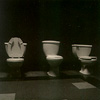 The Gomco Clamp is a special medical device created to facilitate the circumcision of infant boys, a bell-shaped device over which the shaft skin of the penis is stretched before a circular incision is made. On the first track of Thighpaulsandra's new album, tastefully entitled Rape Scene, the eccentric Welshman hints at a joyful misuse of this medical device, and the mind reels at the sadomasochistic possibilities inherent in such a suggestion.
The Gomco Clamp is a special medical device created to facilitate the circumcision of infant boys, a bell-shaped device over which the shaft skin of the penis is stretched before a circular incision is made. On the first track of Thighpaulsandra's new album, tastefully entitled Rape Scene, the eccentric Welshman hints at a joyful misuse of this medical device, and the mind reels at the sadomasochistic possibilities inherent in such a suggestion.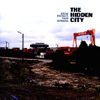 Sub Rosa has a habit of releasing highly conceptual compilations, whereoften times the ingenuity of a particular track or artist gets lost inthe maintenance of vague thematics or some all-too-constrictive"grounds" for collection. The Hidden Cityis no exception, though the level field and loose connectivity of thefeatured artists seems actually to work in favor of the theme: aportrait of Göteborg, the complexity of a city that entered the modernera as one of Sweden's most established port cities, liberalized andglobalized long before the rest of its country and much of Europe, onlyto be swiftly clouded over as Copenhagen and Oslo rose to meet the newcentury's demands. Göteborg's "enlightened," early-global statusapparently outlived its economic promise, and the place has sincebecome a haven for liberal thinkers, artists, and the odd manufacturingmogul (Volvo). There exists here a strange middle-ground between oldworld textbook civilizations and the alienating modernist upstarts;Göteborg survives with pieces of both, a diversity duly reflected inthe city's musicians, poets, and sound-artists. These "sound portraits"are not simple inspiration pieces, but reflections and meditations onactual places within the city, often linked to particular addresses.They create an uneven mosaic of sound in which not one is allowedsupremacy or any definite version of Göteborg's confused history.Pieces of the land's proud past and contemporary persistence comethrough in the orchestral work of composer Peter Hansen, whose "WinterAir" locates an elegance and Norse melancholy that feel like fixtureshovering oblivious to the city's shifting traditions. By contrast,local sound artist Johannes Heldén's contribution, aptly-titled"Bäckegatan 36," incorporates field captures and other incidentalsounds in a gem of dirge-like bedroom electronics, challenging theauthenticity of isolationism and the assumed consistencies connectedwith something as simple as a "fixed" address. Paul Bothén, anothersound artist, creates "Oh Lord" through a collage of recordings from aSwedish barroom performance of a modified gospel tune from the AmericanSouth. His layered cuts create a chilling, gothic atmosphere as muchrelated to Göteborg's uniquely "informed" brand of nationalism as tothe city's more recent financial anxiety ("Oh Lord, won't you buy me acolor TV?"). Elsewhere, the new guard of stealthy, dub-infected Germanelectronica gets represented by works from Mapstation and Göteborgresident Anders Ilar, each more subdued than the artist's usual,perhaps in reaction to Göteborg's own restless quiet. Christina Kubischand Alva Noto come through with two of the more aurally pleasingcontributions on the disc, both technically unimpressive pieces that dolittle more than add to the dreamy, lost city feel of the whole. Thereal pleasures of The Hidden City, though, come from watchingthese well known out-of-towners compete with the singular visions oflocal musicians, including works by Henrik Rylander and Sheriff, andthe poets Anna Eriksson and Fredrik Nyberg. These are the artists thatbring Göteborg to life, with a local color of innumerable shades,revealing the hidden treasure that such a compilation boasts.
Sub Rosa has a habit of releasing highly conceptual compilations, whereoften times the ingenuity of a particular track or artist gets lost inthe maintenance of vague thematics or some all-too-constrictive"grounds" for collection. The Hidden Cityis no exception, though the level field and loose connectivity of thefeatured artists seems actually to work in favor of the theme: aportrait of Göteborg, the complexity of a city that entered the modernera as one of Sweden's most established port cities, liberalized andglobalized long before the rest of its country and much of Europe, onlyto be swiftly clouded over as Copenhagen and Oslo rose to meet the newcentury's demands. Göteborg's "enlightened," early-global statusapparently outlived its economic promise, and the place has sincebecome a haven for liberal thinkers, artists, and the odd manufacturingmogul (Volvo). There exists here a strange middle-ground between oldworld textbook civilizations and the alienating modernist upstarts;Göteborg survives with pieces of both, a diversity duly reflected inthe city's musicians, poets, and sound-artists. These "sound portraits"are not simple inspiration pieces, but reflections and meditations onactual places within the city, often linked to particular addresses.They create an uneven mosaic of sound in which not one is allowedsupremacy or any definite version of Göteborg's confused history.Pieces of the land's proud past and contemporary persistence comethrough in the orchestral work of composer Peter Hansen, whose "WinterAir" locates an elegance and Norse melancholy that feel like fixtureshovering oblivious to the city's shifting traditions. By contrast,local sound artist Johannes Heldén's contribution, aptly-titled"Bäckegatan 36," incorporates field captures and other incidentalsounds in a gem of dirge-like bedroom electronics, challenging theauthenticity of isolationism and the assumed consistencies connectedwith something as simple as a "fixed" address. Paul Bothén, anothersound artist, creates "Oh Lord" through a collage of recordings from aSwedish barroom performance of a modified gospel tune from the AmericanSouth. His layered cuts create a chilling, gothic atmosphere as muchrelated to Göteborg's uniquely "informed" brand of nationalism as tothe city's more recent financial anxiety ("Oh Lord, won't you buy me acolor TV?"). Elsewhere, the new guard of stealthy, dub-infected Germanelectronica gets represented by works from Mapstation and Göteborgresident Anders Ilar, each more subdued than the artist's usual,perhaps in reaction to Göteborg's own restless quiet. Christina Kubischand Alva Noto come through with two of the more aurally pleasingcontributions on the disc, both technically unimpressive pieces that dolittle more than add to the dreamy, lost city feel of the whole. Thereal pleasures of The Hidden City, though, come from watchingthese well known out-of-towners compete with the singular visions oflocal musicians, including works by Henrik Rylander and Sheriff, andthe poets Anna Eriksson and Fredrik Nyberg. These are the artists thatbring Göteborg to life, with a local color of innumerable shades,revealing the hidden treasure that such a compilation boasts. - Alva Noto - Party Plasibenpius (For Rune Lindblad)
- Peter Hansen - Winter Air
- Johannes Heldén - Bäckegatan 36



